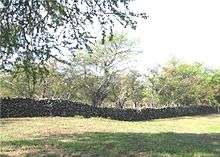Hawaiian wild cattle
Hawaiian wild cattle are a feral breed of domestic cattle (Bos taurus[1])[2] introduced at the end of 18th century. Thousands[3] of them are still freely roaming forested[3] areas on the Island of Hawaiʻi.[4][5]
History
In 1793 and in 1794 Captain George Vancouver gave four bulls and eight cows[4] to Hawaiian king Kamehameha I. Kamehameha placed a kapu (Hawaiian taboo) on the hunting of the feral cattle which was not lifted until 1830.[4][5] As a consequence by 1846 25,000 cattle were roaming the countryside in addition to 10,000 semi-domesticated cattle.[5] The huge herds were destroying crops and sometimes even killing people so hunting was begun to reduce numbers of animals.[5] In 1832 Kamehameha III invited vaqueros from California, then part of Mexico, to train native Hawaiians in managing the wild livestock, which led to the development of Hawaiian cowboys - paniolos.[7][8]
The trampled dead body of Scottish botanist David Douglas (discoverer of the Douglas fir) was found in 1834 in a bullock pit on Mauna Kea. Those traps were known for catching people, but the possibility of murder was considered in this case.[5]
Feral cattle contributed significantly to the decline of many plant species in the Hawaiian Islands.[3]
Today the Department of Land and Natural Resources' (DLNR) Division of Forestry and Wildlife (DOFAW) is involved in feral cattle eradication, organizing lotteries for special access feral cattle control.[9][10][11] The hunt is not easy as animals have, over the generations, become smaller and wild. Similarly the local feral sheep have developed longer legs.[11] Vehicles frequently hit cows congregated on roads enjoying the sun heated asphalt. The local legend of "invisible cows" on Mauna Kea originates from these crashes. Road signs warning against cows in darkness or fog are common.[4]
See also
- Cattle
- Cowboy - Hawaiian Paniolo
- Feral organism
References
- ↑ Grubb, P. (2005). "Bos taurus". In Wilson, D.E.; Reeder, D.M. Mammal Species of the World: A Taxonomic and Geographic Reference (3rd ed.). Johns Hopkins University Press. pp. 637–722. ISBN 978-0-8018-8221-0. OCLC 62265494.
- ↑ "The Public Health Information Network (PHIN) Vocabulary Access and Distribution System (VADS)". Centers for Disease Control and Prevention (CDC). 2014. Retrieved 16 July 2014.
- 1 2 3 Loope, Lloyd L. (1998). "Hawaii and the Pacific Islands" (PDF). In Opler, Paul A.; Puckett Haecker, Catherine E.; Doran, Peter D. Status and Trends of the Nation's Biological Resources. Volume 2: Regional Trends of Biological Resources. Michael J. Mac - Project Director. Reston, Va: U.S. Department of the Interior, U.S. Geological Survey. pp. 747–774. ISBN 016053285X. Retrieved 2014-07-18.
- 1 2 3 4 "Domestic Cow - Mauna Kea Visitor Information Station". Mauna Kea Support Services / Mauna Kea Visitor Information Station. 2010. Retrieved 30 March 2014.
- 1 2 3 4 5 "Introduction of Cattle - Hawaii History - The Paniolo". HawaiiHistory.org. 2014. Retrieved 30 March 2014.
- ↑ A Guide to Old Kona. Kalukalu, Kona: University of Hawaii Press. 1998. pp. 19–20. ISBN 0-8248-2010-X. Retrieved 2014-07-16.
- ↑ Fischer, John Ryan (August 2007). "Cattle in Hawai'i: Biological and Cultural Exchange". Pacific Historical Review. University of California Press. 76 (3): 347–372. doi:10.1525/phr.2007.76.3.347. Retrieved 13 July 2014.
- ↑ "Mexican Vaquero - Hawaii History - The Paniolo". HawaiiHistory.org. 2014. Retrieved 30 March 2014.
- ↑ Ward, Deborah (2013). "DLNR Plans Lottery For Special Access Feral Cattle Control In Pu'u 'O'o Area Of Hilo Restricted Watershed | Hunter Education Program". Department of Land and Natural Resources (DLNR). Retrieved 30 March 2014.
- ↑ "DLNR PLANS A NEW LOTTERY DRAWING FOR SPECIAL ACCESS FERAL CATTLE CONTROL IN HILO RESTRICTED WATERSHED | Division of Forestry and Wildlife". Department of Land and Natural Resources (DLNR). 2013. Retrieved 30 March 2014.
- 1 2 Cook Lauer, Nancy (2014). "DLNR looking for more cattle hunters". Stephens Media LLC. Retrieved 30 March 2014.
External links
- Videos: Another Wild Cattle Hunt, wild cattle of Maui Hawaii, Wild Cattle Herd Hawaii (YouTube)
